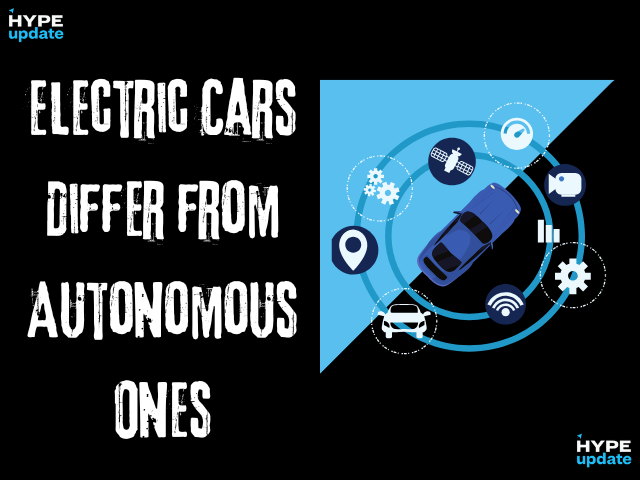How Do Electric Cars Differ from Autonomous Ones ,Though seeming intimately linked, electrified and autonomous cars are separated by many technical distinctions like connectivity, data recorders, and the “Tesla trend.”
Your studies will cover:
- Technically, how do EVs and AVs differ? How about customer attitude?
- What does “Tesla trend” mean?
- The need for in-vehicle data recorders in AVs.
Apart from sharing a letter in their acronym, EVs and autonomous vehicles (AVs) now have a connection of just affiliation. Having left the R&D lab and entered the cultural zeit, both have gained more consumer awareness in the last several years.
However, notable technical differences separate the two, consumers perceive them differently, and their fascinating, complementary relationship will continue evolving as the world adopts EVs and AVs on a mass scale
The Tech Variations Between AVs and EVs
In one form or another, EVs have existed for quite some time. An EV eventually simply depends on another kind of propulsion when you cut past the novelty, pomp, and circumstance; this contrasts with petrol, diesel, and now hydrogen fuel cells.
Electric propulsion makes components largely similar to all EVs and basically quite simple—motor(s), battery, and controls for those components to enable power application, regenerative braking, and charging.
Control systems are now comparable in every vehicle type—fly-by-wire motor control, electronic gearbox control, brake-by-wire, electric power steering—meaning the application of driver aids on these systems is done via electronic communication between a network of modules.
The “Tesla Trend” and Its Effect on the EV Car Sector
Let’s call it the “Tesla trend”; the present drive towards EVs has coincided with developments in autonomy. This company (Tesla) has not only started an electric brand utilising more efficient battery technology than previously seen, but also loaded it with supposed cutting-edge driving assistance. In a sense, this has turned the vehicle into an even more essential tech accessory, which attracts a different population than, example, a conventional internal-combustion-engine (ICE) “analogue” automobile.
The reaction has been mixed; conventional car makers have found it difficult to keep up with the change in attitude. Among the current automobile inventory, Volvo most likely pioneered assisted driving. The firm also launched hybrid or electric vehicle options under its Polestar brand to guarantee it could be seen as a competitor for Tesla at the same time. Other carmakers are following suit at a quicker rate, including Volkswagen with its new “ID” series of electric vehicles and BMW with its recent iX and i4 introductions.
In-Vehicle Data Loggers: What Are They and Why Do AVs Need Them?
Integral components of technology allowing AVs to operate are in-vehicle data recorders. Whether drivers make these changes manually or an AI/machine-learning algorithm handles them automatically, they cannot regularly improve how the entire system behaves without the ability to record data while the car is in motion. Moreover, from a legal standpoint, on-the-road testing of advanced driver-assistance systems (ADAS) and AV algorithms is expensive, almost hazardous, and difficult.
Loggers are aggregators collecting data from automotive body-mounted sensors like cameras, LiDAR, radar, and GPS. Later, engineers can use this data to recreate driving conditions on test benches in the safe, controlled lab environment. This allows them to generate observations and implement necessary changes.
Aiming particularly at the degrees of autonomy, we all know the pictures of autonomous cars packed with sensors, which are R&D vehicles at the Level 4/Level 5 end of autonomy, i.e. complete autonomy (Fig. 1). You could have spotted one driving along your block! Effectively machine-learning cars, these ones collect data depending on actual situations where factors like traffic, roadworks, moving objects, weather, daylight, and road conditions interact.
Significance of Connectivity
From sensors to loggers, then the transfer from loggers to storage networks, and ultimately the upload to the public/private cloud, advances in device connection and IoT have been vital in facilitating the end-to-end process of data collection, input, and output in AVs. Operating systems like Klas’s KlasOS Keel are a further enabler of this general data web.

Such a strong degree of data collecting, transport, and storage greatly streamlines the R&D process. It will also enable producers to decide which cameras and sensors are pertinent and where technological gaps exist. Manufacturers may create a more visually beautiful vehicle by incorporating the needed production hardware as part of the design using a refined well-proven onboard algorithm on an autonomous platform along with the necessary ever-evolving input devices.
Currently, the Klas angle is at the R&D stage for level 4 and level 5 autonomy (Fig. 2). Today, the R&D logger (TRX D8) collects driving data during test trips. Engineers offload and analyze this data after each drive, using it to continuously improve algorithms. The TRX D8 is the in-vehicle compute-and-storage component; the ingest server is the offload method Klas now provides utilising a Dell server and its physical ingest receptacles.
Apart from the TRX D8 R&D Data Logger, Klas provides Compute, GPU, Switch, and Cellular Backhaul devices all with the same modular form size as the TRX D8. Complemented by the company’s selection of in-vehicle chassis-mount choices, the products work together to provide a market-ready solution for most components used in the autonomous-vehicle R&D sector.
